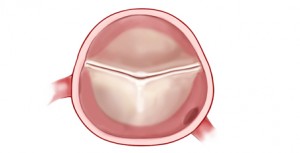Approximately 30% of individuals with Turner syndrome are diagnosed with congenital heart defects. The most common cardiac defect in TS is a “bicuspid aortic valve,” which means that the valve that regulates blood flow from the heart has two flaps. A typical heart has a tricuspid aortic valve, or a valve with three flaps. This condition is discovered mainly by medical imaging studies and may not be clinically obvious. It requires careful medical monitoring, since bicuspid aortic valves can deteriorate or become infected. Comprehensive screening and evaluation by a cardiologist with expertise in congenital heart conditions is essential for all patients with Turner syndrome at the time of diagnosis. The evaluation should include cardiac magnetic resonance as well as echocardiography and EKG/ECG.
Between 5 and 10% of children with Turner syndrome have been found to have a severe constriction of the major blood vessel coming out from the heart, a condition known as “coarctation of the aorta.” This can be surgically corrected as soon as it is diagnosed and requires lifelong monitoring. To see a resource from the National Institutes of Health that offers diagrams of the most common heart defects in TS, click HERE.
Many women with Turner syndrome have high blood pressure, which may be apparent even in childhood. In some cases this high blood pressure may be due to aortic constriction or to kidney abnormalities. In a majority of women, however, no specific cause for the high blood pressure has been found. Click HERE to see a 2016 research article titled Pilot Study of Blood Pressure in Girls with Turner Syndrome.
CARDIAC ALERT
IMPORTANT CARDIAC INFORMATION FOR TURNER SYNDROME
ALL Turner syndrome patients presenting with severe chest pain should be considered for an aortic dissection until findings show otherwise
Although aortic dissection and rupture occur rarely, it is important to know that those with Turner syndrome are at increased risk. Turner syndrome patients with one or more risk factors, including hypertension, bicuspid aortic valve, aortic dilation, and pregnancy present with an even higher risk of aortic dissection. However, 10%-25% of girls and women with Turner syndrome who have experienced aortic dissection had no risk factors aside from a diagnosis of Turner syndrome.

NEW RESEARCH
IMPORTANT CARDIAC RESEARCH ARTICLE


CHECKLIST
Access the Clinical Practice Guidelines here for cardiac guidelines and more

Aortic Dilatation & Dissection

Coarctation of the Aorta
Visual Resource – NIH U.S. National Library of Medicine
New York Times – The aorta carries blood from the heart to the vessels that supply the body with blood and nutrients. If part of the aorta is narrowed, it is hard for blood to pass through the artery.

Hypertension

Hypertension and ischemic cardiovascular disease in Turner Syndrome 2006 – Hypertension occurs in many patients with Turner syndrome (TS), probably approaching 50% in aging populations. Hypertension seems to be of the essential type, although the reason for the high frequency is unknown. Hypertension should be looked for, and treated appropriately. Hypertension is probably linked to the frequent occurrence of aortic dissection in TS.
Hypertension and Turner syndrome 2016 – Results show girls with Turner syndrome should be carefully monitored in childhood and adulthood for blood pressure and other cardiovascular risk factors.
Pregnancy and Cardiac Risks
See our page Fertility and Pregnancy for these resources
Additional Research and Resources
Prolongation of the Cardiac QTc Interval in Turner Syndrome 2006
Major Vascular Anomalies in Turner Syndrome: Prevalence and Magnetic Resonance Angiographic Features 2004
Association Between Fetal Lymphedema and Congenital Cardiovascular Defects in Turner Syndrome 2006
Growth Hormone Treatment and Left Ventricular Dimensions in Turner Syndrome 2007
Cardiovascular abnormalities in Turner’s syndrome: What prevention? 2008














